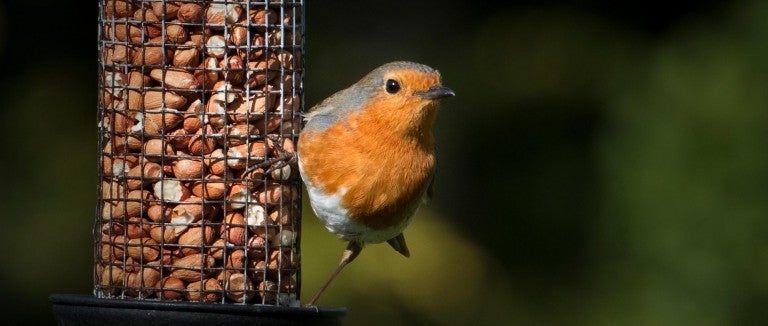Keeping your pet cats inside is the best way to ensure their safety and protect wild animals in the area. But if you’re feeding community cats or your neighbors let their kitties roam—and you also enjoy putting out bird feeders—follow these tips to promote everyone’s safety.
Top 15 cat tips
Sign up to receive our exclusive e-book full of important information about keeping your cat healthy and happy.

- The best way to provide food for local birds while also protecting them from outdoor cats (and wildlife) is to replace some or all of your bird feeders, which concentrate feeding at one location, with native plants that provide seeds, berries and insects for birds to eat as well as cover and nesting spots. (Using native plants to attract and nourish your backyard birds also avoids the risk that your feeders may facilitate disease transmission among birds.)
- Position feeders at least 12 feet away from grass and shrubs, which can serve as good cat cover. If possible, place the feeders within 15 feet of trees, where birds can hide or flee from hawks or other avian predators.
- If you can, hang feeders on a wire strung at least 8 feet above the ground, between two trees that are at least 8 feet apart.
- If your feeder is mounted on a pole, install a predator guard (a metal cone with the wide bottom facing down) to keep cats and other animals from climbing up.
- Place circular fences, about 2 feet high and 4 feet in diameter, on the ground directly below feeders to make it difficult for cats and other predators to creep up on birds.
- Use high-quality food that birds will be sure to devour, rather than letting some of it fall to the ground, and install a spill tray to catch seeds.
- Place sharp-edged gravel beneath feeders, or lay small-gauge chicken wire, a plastic carpet runner with the knobby side up or a deterrent mat such as the Cat Scat brand under a shallow layer of dirt or mulch. Cats don’t like walking on these types of irregular surfaces.
- Drive cats away from feeders with a motion-activated ultrasonic product that sends out a burst of high-pitched noise—inaudible to humans but uncomfortable for cats (choose a model that uses a frequency that won’t disturb birds). Or install a motion-activated sprinkler to scare away any cat who approaches the feeder. Get tips for using deterrents and other strategies for keeping cats out of areas where they’re not welcome.
- To avoid attracting cats and other unwanted guests to your yard, store garbage in a container with a lid that locks in place, and check out these tips for preventing raccoons and squirrels from raiding your bird feeders.
- If you feed outdoor cats, make sure they are spayed or neutered and follow these feeding guidelines. Don’t leave cat food out 24/7, as this can attract additional cats and other predators.
- Find more bird feeding advice, including tips for avoiding window strikes, choosing the right foods for wild birds, cleaning your bird feeder and more.
